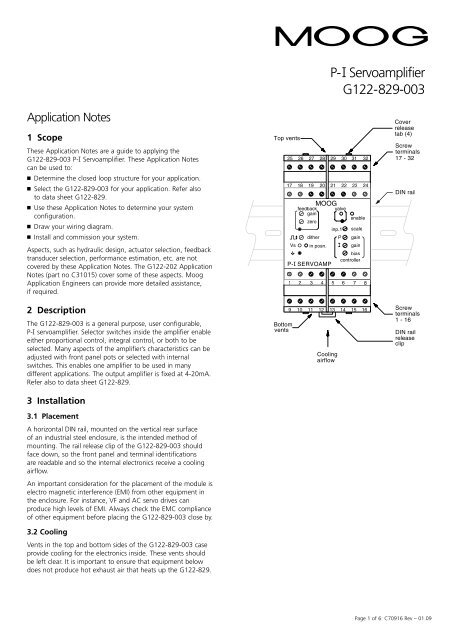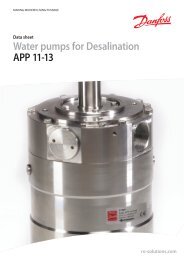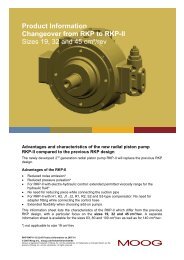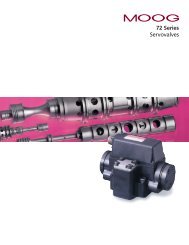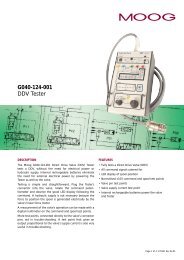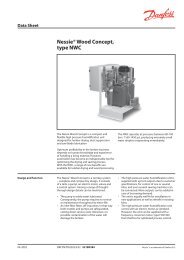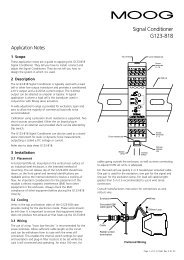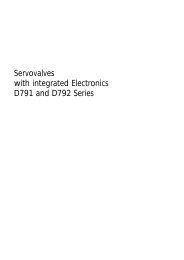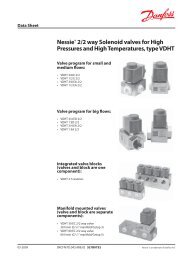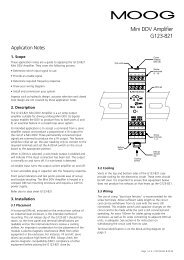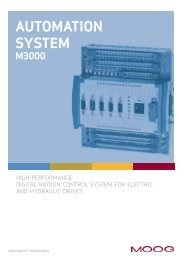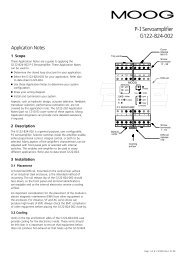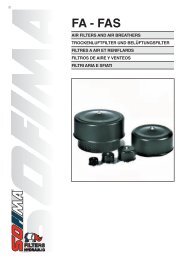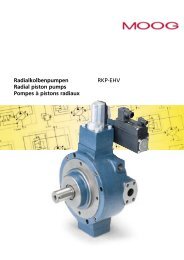G122-829-003 Series P-I Servoamplifier - Moog Inc
G122-829-003 Series P-I Servoamplifier - Moog Inc
G122-829-003 Series P-I Servoamplifier - Moog Inc
- No tags were found...
You also want an ePaper? Increase the reach of your titles
YUMPU automatically turns print PDFs into web optimized ePapers that Google loves.
P-I <strong>Servoamplifier</strong><strong>G122</strong>-<strong>829</strong>-<strong>003</strong>Application Notes1 ScopeThese Application Notes are a guide to applying the<strong>G122</strong>-<strong>829</strong>-<strong>003</strong> P-I <strong>Servoamplifier</strong>. These Application Notescan be used to: Determine the closed loop structure for your application. Select the <strong>G122</strong>-<strong>829</strong>-<strong>003</strong> for your application. Refer alsoto data sheet <strong>G122</strong>-<strong>829</strong>. Use these Application Notes to determine your systemconfiguration. Draw your wiring diagram. Install and commission your system.Aspects, such as hydraulic design, actuator selection, feedbacktransducer selection, performance estimation, etc. are notcovered by these Application Notes. The <strong>G122</strong>-202 ApplicationNotes (part no C31015) cover some of these aspects. <strong>Moog</strong>Application Engineers can provide more detailed assistance,if required.2 DescriptionThe <strong>G122</strong>-<strong>829</strong>-<strong>003</strong> is a general purpose, user configurable,P-I servoamplifier. Selector switches inside the amplifier enableeither proportional control, integral control, or both to beselected. Many aspects of the amplifier’s characteristics can beadjusted with front panel pots or selected with internalswitches. This enables one amplifier to be used in manydifferent applications. The output amplifier is fixed at 4-20mA.Refer also to data sheet <strong>G122</strong>-<strong>829</strong>.3 Installation3.1 PlacementA horizontal DIN rail, mounted on the vertical rear surfaceof an industrial steel enclosure, is the intended method ofmounting. The rail release clip of the <strong>G122</strong>-<strong>829</strong>-<strong>003</strong> shouldface down, so the front panel and terminal identificationsare readable and so the internal electronics receive a coolingairflow.An important consideration for the placement of the module iselectro magnetic interference (EMI) from other equipment inthe enclosure. For instance, VF and AC servo drives canproduce high levels of EMI. Always check the EMC complianceof other equipment before placing the <strong>G122</strong>-<strong>829</strong>-<strong>003</strong> close by.3.2 CoolingVents in the top and bottom sides of the <strong>G122</strong>-<strong>829</strong>-<strong>003</strong> caseprovide cooling for the electronics inside. These vents shouldbe left clear. It is important to ensure that equipment belowdoes not produce hot exhaust air that heats up the <strong>G122</strong>-<strong>829</strong>.Top vents2517BottomventsVs26182719feedbackgainzero28201 2 3 49 10 11 122921MOOGditherin posn.3022valveinp.1CoolingairflowPI3123enablescalegaingainbiascontroller32245 6 7 813 14 15 16Coverreleasetab (4)Screwterminals17 - 32DIN railScrewterminals1 - 16DIN railreleaseclipPage 1 of 6: C70916 Rev – 01.09
3.3 WiringThe use of crimp “boot lace ferrules” is recommended for thescrew terminals. Allow sufficient cable length so the circuitcard can be withdrawn from its case with the wires stillconnected. This enables switch changes on the circuit cardto be made while the card is still connected and operating.An extra 100mm, for cables going outside the enclosure,as well as wires connecting to adjacent DIN rail units,is adequate.The screw terminals will accommodate wire sizes from 0.2mm 2to 2.5mm 2 (24AWG to 12AWG). One Amp rated, 0.2mm 2should be adequate for all applications.EnclosureGrounded EMIcable glandCableWires100mm Loop5 Set-up adjustmentsEorPcmd lagInput 2 toerror ampInput 3 tooutput ampfeedback leadSW2 V orSW5 V orSW4R34R16SW5SW3SW6P gain rangeR33R17[SW1]Step P.B.1234sparePRlimINT1 spare2 enable3 dither4 4-20mA (feedback input)To access the circuit card switches, the circuit card must bewithdrawn from the case. See paragraph 17.SW1 + 6 switch positionsRadial screenterminationONshown in on positionshown in off positionPreferred WiringEnclosureCable glandCable3.4 EMCWire solderedto screenorDrain wire.(Heat shrink tocover the screen)Alternative WiringCable100mm LoopThe <strong>G122</strong>-<strong>829</strong>-<strong>003</strong> emits radiation well below the level calledfor in its CE mark test. Therefore, no special precautions arerequired for suppression of emissions. However, immunity fromexternal interfering radiation is dependent on careful wiringtechniques. The accepted method is to use screened cables forall connections and to radially terminate the cable screens, inan appropriate grounded cable gland, at the point of entry intothe industrial steel enclosure. If this is not possible, chassisground screw terminals are provided on the <strong>G122</strong>-<strong>829</strong>-<strong>003</strong>.Exposed wires should be kept to a minimum length. Connectthe screens at both ends of the cable to chassis ground.Trimpots are all 15 turns.Plug-in resistors are all “quarter watt” 1% metal film. Twosuitable types are Beyschlag MBB0207 and RodersteinMK20207.The amplifier is shipped in the following default state.top board switchesSW3 STEP not applicableSW4-1 P-E ESW4-2 CMD LAG offSW5 IN 2 VSW6 1 spare off2 PR on3 I Lim off4 INT off bottom board switch, shown as [ ][SW1] 1 spare off2 ENABLE on3 DITHER off4 4-20mA on R17: 100k (P gain range 1 to 20) R34: 100k (input 2 to error amp) R33: not fitted (input 3 to output amp) R16: not fitted (feedback derivative)4 Power supply24V DC nominal, 22 to 28V75mA @ 24V without a load, 200mA @ 100mA load.If an unregulated supply is used the bottom of the ripplewaveform is not to fall below 22V.It is recommended that an M205, 250mA T (slow blow) fuse,compliant with IEC127-2 sheet 3, be placed in series with the+24V input to protect the electronic circuit.Page 2 of 6: C70916 Rev – 01.09
Feedback gain and zero pots: configured for 4-20mA input Dither level pot: fully counter clockwise (FCCW) Scale pot: FCCW P gain pot: FCCW I gain pot: FCCW Bias pot: 0VCautionIf you intend to use the feedback amplifier adjusted for4-20mA, don’t change the feedback gain or zero. They are already adjusted for 4-20mA To re-adjust for 4-20mA takes a little time, needs testequipment and is tedious to do in the field.6 Input configurationInputs 1, 2 and feedback go to the error amplifier and can beused for feedback or command. Care needs to be taken inselecting signal polarity to achieve negative feedback forthe overall closed loop. Since the input error amplifier sumsthe signals, the transducer feedback signal needs to be theopposite polarity of the command. This can be achieved intwo ways: Arrange for an opposite polarity feedback transducer signaland connect it to input 1, input 2 or the positive feedbackamplifier input. If the feedback transducer signal is the same polarity as thecommand, you only have one option: Connect it to thenegative input of the feedback amplifier.6.1 Feedback inputAn input to the error amplifier: The feedback amplifier is thebest choice for the feedback signal, for six reasons: It leaves input 1 available for command. See 6.2 below. It has inverting (negative) and non-inverting (positive) inputs. It has zero and gain adjustment pots. This enables a signalthat does not go to zero volts and has less span than thecommand, to be scaled up to the command. While this isnot essential, it helps when setting up and trouble-shooting. There is a front panel test point for the zeroed and amplifiedsignal. This is very convenient (essential) for setting up andtrouble-shooting. There is the option of a plug-in resistor, R16, to give afeedback derivative (lead or D) in the output of the feedbackamplifier. It can be set up for a current input by connecting a 240 Ohmresistor between terminals 17 and 18 with the 4-20mAswitch ([SW1-4]).DefaultThe feedback amplifier default set-up is 4-20mA flowing intoterminal 18 and out of terminal 17, producing an output of0 to -10V. Reversing the terminals, and hence the current flow,will not result in a 0 to +10V output. The feedback zero mustbe adjusted for this arrangement.Adjusting feedback amp for 4-20mA input and0 to -10V output Set the feedback gain to minimum (fully counter clockwise).The trimpot has 15 turns and will click when minimum isreached. Connect terminal 17 to terminal 26 (ground). Connect the positive of a variable DC power supply toterminal 18 and the negative to terminal 26. Connect a digital multimeter (DMM), on DC Volts, betweenthe front panel feedback amp and ground test points. Set the variable supply to 0.96V. Adjust the feedback amp zero trimpot until the DMM reads0.00V. Set the variable supply to 4.80V. Adjust the feedback gain trimpot until the DMM reads-10.00V. Set the variable supply to 0.96V again and check thefeedback test point is still 0.00V. Trim if necessary and checkthe 4.80V setting again.6.2 Input 1An input to the error amplifier: This input is ±10Vnon-inverting and has two important features: It has a scale pot on its input that enables large inputs to bescaled down to match smaller signals on other inputs. Scalerange is 10 to 100%. Set fully clockwise (FCW), an input of100V can match a 10V signal on the other inputs. Note thatthe maximum permissable input voltage is ±95V. It has a switch selectable lag (SW4-2) of 55mS that can beused to remove transients from the input signal that couldcause unwanted rapid movement in the output.Input 1 is well suited to be a command because of these twofeatures. If input 1 is used for feedback, be sure the lag isswitched off. Input resistance after the scale pot is 94k Ohms.6.3 Input 2An input to the error amplifier: This input is non-inverting. It isswitch selectable (SW5) between 4-20mA and ±10V. The4-20mA converter produces 0 to +10V for 4 to 20mA input.R34 connects from the output of the converter to the input ofthe servo amp when 4-20mA is selected. Plug-in input resistorR34, of 100k Ohms, gives a nominal 0 to 10V input signalrange when V rather than 4-20mA is selected. Input 2 issuitable for command or feedback. R34 can be increased togive a larger input range.6.4 Input 3An input to the output summing and limiting amplifier via aplug-in resistor, R33. A typical use for this input is commandfeed forward. With R33 at 10k Ohm, a ±10V input will produce±100% valve drive. <strong>Inc</strong>reasing R33 reduces the valve drive.7 Output configurationThe output signal is 4-20mA. No other signal type can beselected. Permissable load range is 0 Ohm to 500 Ohm.Nominal null output is 12mA.The output amplifier is limited to approximately 105% of theselected full scale output. If both the proportional andintegrator stages are saturated, the output will not be twicethe selected full scale but still only 105% of full scale.8 Step push buttonThe step push button (SW3) injects -50% valve drivedisturbance into the output. When released, the valve drivereverts to its original level. This feature is useful for closed loopgain optimisation.9 P-I selectionFor position closed loops, initially select only P (SW6-2).For pressure or velocity loops select I (SW6-4) initially andthen P. See paragraph 12 below for more detail. For acomplete discussion of P and I control, see the <strong>G122</strong>-202servoamplifier Application Notes (part no C31015).Page 3 of 6: C70916 Rev – 01.09
10 Integrator inputThe servoamplifier has a unity gain input error amplifierfollowed by two parallel stages, one a proportional amplifierand the other an integrator. The outputs of these two stagescan be switched to the output power amplifier (see paragraph7 above) which then drives the valve.The input to the integrator stage can be switch selected(SW4-1) from either the output of the error amplifier, I in = E,or the output of the proportional stage, I in = P. The latterarrangement is used in the <strong>G122</strong>-202. It is beyond the scopeof these Application Notes to detail the benefits of eacharrangement. If you have experience with the <strong>G122</strong>-202,I in = P would seem to be an easy choice.11 P only gainFor position loops select only P control (SW6-2). Input a stepdisturbance of 50% valve current with the step push button(SW3). Adjust the P gain for the required stability, whilemonitoring the front panel valve test point, or the feedbacksignal. The gain range of the proportional amplifier can bemoved by changing the plug-in resistor R17. The value loadedwhen shipped is 100k Ohms, which gives a 1 to 20 range.Selecting 200k Ohms will give 2 to 40. The circuit will functioncorrectly with the value of R17 between 100k Ohms and 10MOhms.Note that as P gain is increased, the movement due to the steppush button decreases.12 P and I gains togetherIf you are inexperienced with integral control the followingset-up method is a good starting point. I in = E: Initially select only I (SW6-4). Press the step pushbutton (SW3). <strong>Inc</strong>rease I gain until one overshoot in thefeedback signal is observed.Next select P (SW6-2) and I (SW6-4) together and increase theP gain to reduce the overshoot.For the I in = E arrangement the P and I sequence could bereversed. i.e.: adjust P first, followed by I. I in = P: For an I in = P arrangement, only the “P followedby I” sequence of adjustment can be used.For a more thorough discussion see <strong>G122</strong>-202 ApplicationNotes (part no C31015).15 EnableA relay on the circuit card needs to be energised to connectthe output stage to its screw terminal and to un-clamp theintegrator. The clamp prevents integrator wind-up when theloop is not operating. Supply 24V to the appropriate terminalto energise the relay. The enable switch ([SW1-2]) on the circuitcard can be set to permanently energise the relay and providea permanent enable.16 In positionWhen the valve drive signal falls below ±10% of full scalesignal, the “in position” signal goes true and provides anopto-isolated current path between the + and – terminals.This can be connected to a PLC to initiate the next step ina control sequence. Do not apply more than 40V to the+ terminal and ensure the load on the – terminal is lessthan 20mA.The “in position” signal is not relevant for a velocity loop.17 Withdrawing the circuit cardfrom its caseThe circuit card needs to be withdrawn from its case to set theselector switches, change the plug-in resistors and operate thestep push button.To do this, push one cover release tab with a pen orscrewdriver, while gently pulling on the top cover on that side.The cover will release approximately one mm. Repeat on thesecond tab on that side. Repeat on the other side and thenwithdraw the cover and circuit card until the required switchesare exposed. The rigidity of the connecting wires will hold thecircuit card in position while changes are made.13 I limitThe contribution from the integrator to the output amplifiercan be reduced by selecting I limit on (SW6-3). When thisswitch is on the integrator contribution is reduced toapproximately 15% of the level when it is off. This feature isuseful in a position loop that may require integral control toachieve the required steady state accuracy. The limited integralcontrol removes valve null error when the final position isreached. It is also useful in a pressure loop to limit overshoot,if the valve drive saturates.14 DitherThe dither frequency is fixed at 200Hz and the level isadjustable with the front panel pot to ±10% of valve drive,regardless of the type and level of valve drive selected. It canbe turned on or off with ([SW1-3]). Dither is seldom needed ina position loop but can be beneficial in pressure or velocityloops. <strong>Inc</strong>rease dither until it can just be detected in thecontrolled variable, such as pressure or velocity. Dither cancompromise valve life, so it should be kept to a minimum.Page 4 of 6: C70916 Rev – 01.09
18 SpecificationsFunction:P, I, or P & I, switch selectableInput 1:Scaled to 95V max with switchselectable lag of 55mS.Input 2:Switch selectable.4-20mA 240R load, for 0 to +10V on R34.Or 0 to ±10V direct onto R34.R34 is plug-in, 100K nominal.Input 3:R33 plug-in. ±10V gives ±100% valvedrive when R33 = 10k Ohm, ±10% whenR33 = 100k Ohm.Feedback input: Differential 4-20mA or ±10V, switchselectable±15V max.R in 100k – ±10VR in 240R – 4-20mAFeedback amp: Zero, ±10V.Gain, 1 to 10.Derivative (velocity) feedback viaplug-in resistor R16 and fixed capacitor.Transducer excitation: +10V @ 10mA max.Error amp:Unity gain.Bias ±1.5V.Proportional amp gain: 1 to 20.Integrator gain: 1 to 45 per second.Integrator input: Switch selectable from output of unitygain error amp or proportional gain ampEnable: Relay, +24V @ 8mA, 17 to 32V.Output amp:Fixed at 4-20mA. Nominal null output is12mA. Permissable load range is 0 Ohm to500 Ohm.Step push button: -50% valve drive disturbance.Valve supply:Terminal 23, 300mA max.In position:±10% of valve drive. 20mA and 40V maxoutput to PLC.Front panelVs, internal supply – greenindicators:Valve drive positive – rednegative – greenEnable – yellowIn position – greenFront panelValve ±10V (regardless of outputtest points:signal selection)Feedback amplifier outputsignal 0VFront panelInput 1 scaletrimpots:Error amp bias(15 turns) P gainI gainDither levelFeedback amp gainFeedback amp zeroDither:200 Hz fixed frequency.±10% valve drive. Switch selectableon/offSupply: Terminal 1,24V nominal, 22 to 28V75mA @ 24V, no valve current,200mA @ 100mA valve current±15V output: Terminals 14 and 15,± (110mA – max valve current)Wire size range: 0.2mm 2 to 2.5mm 2(24AWG to 12AWG)Recommended M205, 250mA T (slow blow) fusesupply protection: compliant to IEC127-2 sheet 3Mounting:DIN railIP 20Temperature:0 to +40ºCDimensions:100W x 108H x 45DWeight:180gCE mark:EN50081.1 emissionEN61000-6-2 immunityC tick:AS4251.1 emission19 Internetwww.moog.com/dinmodulesPage 5 of 6: C70916 Rev – 01.09
20 Block-wiring diagramSupply+24V0VInput 2see note 1see note 1signal0VrefInput 1signal0Vrefsee note 1+10V0VTypicallinear potfeedback see note 1+Feedback Input0Vref12978165613TransducerExcitation192027171826+10V[SW1-4]4-20mA10K1K+24VscalePower Supply4-20mAConverter47K 47Kcmd lagR33N.F.zero100KR34TP100Kfeedbackgain++VsLEDbiasError AmpAv=1R16N.F.+15V-15Vfeedback lead2.2uFditherDitherOscillatorIntegrator inputselectR17100KditherSW4-1E PTPPgainIntegratorSW6-3gainPGainAmplimOutput AmpTPvalveLEDenableStep P.B.LEDvalveINTPR+24V enable-50%In PositionComparator100R+24V+15V-15V+24V11123410141528232431322213+see note 1see note 125Feedback AmpNote: 1. Connect cable screen to enclosure cable glandor chassis ground terminal on <strong>G122</strong>-<strong>829</strong>-<strong>003</strong>.Note: 2. Connect spool (pin F) to terminal 22,only if the spool signal is a current.ABDEFPLC+24VEnable+24VIn positionefb ValveTypical D66XProp. valvespoolsee note 2mfb ValveConnect topins 31 & 32.+250mATfuseInput 3signal21240R100K100K100KVSW5240R100KVSW5SW4-2[SW1-3]Sum & LimitAmp++-SW3SW6-4SW6-239R[SW1-2]125RNote: 3. Switches shown in default shipping mode.Note: 4. [ ] indicates bottom board.Industrial Controls Division. <strong>Moog</strong> <strong>Inc</strong>., East Aurora, NY 14052-0018. Telephone: 716/652-3000. Fax: 716/655-1803. Toll Free 1-800-272-MOOG.<strong>Moog</strong> GmbH. Germany. Telephone: 07031-622-0. Fax: 07031-622-100.<strong>Moog</strong> Sarl. France. Telephone: 01 45 60 70 00. Fax: 01 45 60 70 01.<strong>Moog</strong> Australia Pty. Ltd. Telephone: 03 9561 6044. Fax: 03 9562 0246.<strong>Moog</strong> pursues a policy of continuous development and reserves the right to alter designs and specifications without prior notice. Information contained herein is for guidance only and does not form part of a contract.Australia: Melbourne, Sydney, Brisbane Austria: Vienna Brazil: S ao ~ Paulo Denmark: Birkerød England: Tewkesbury Finland: Espoo France: Rungis Germany: Böblingen, Dusseldorf Hong Kong: Shatin India: BangaloreIreland: Ringaskiddy Italy: Malnate (VA) Japan: Hiratsuka Korea: Kwangju-Kun Philippines: Baguio City Singapore: Singapore Sweden: Askim USA: East Aurora (NY)Page 6 of 6: C70916 Rev – 01.09


